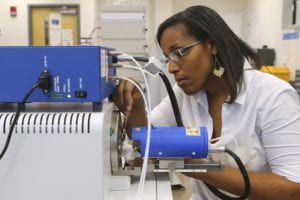Exposing the Reality of Forensic Science

Dr. Candice Bridge (Photo courtesy of UCF Today)
“CSI” and its television spin-off shows make forensic science seem like an exact study that will deliver a sure conviction or exoneration in court. In real life, there’s a lot of confusion about forensic evidence, and other than DNA it is rarely introduced into the courtroom.
University of Central Florida forensic scientist Candice Bridge, Ph.D., is working alongside her peers and a national organization to change that and give prosecutors and public defenders more knowledge about what forensic science can and cannot do. Ultimately, she sees her work as helping victims get justice.
Bridge, who previously worked for the Defense Forensic Science Center and U.S. Army Criminal Investigations Laboratory, knows first-hand what a challenge forensic evidence can be. She was a forensic chemist and worked analyzing evidence from fire debris and explosive cases.
“Outside of the TV shows, most people think forensic science is a difficult field because of the amount of math and chemical formulas that is required in some forensic disciplines,” Bridge said. The general public’s understanding is even more confounded thanks to Hollywood, which hasn’t made it any easier to explain to juries what the evidence can and cannot show.
“Currently, there is a lot of discussion in the academic field itself about the evidentiary value each piece of evidence has in a criminal investigation,” Bridge said.
“Take DNA. There’s a lot of misinformation about it. Yes, DNA can place a person in a location, but it is just one tool. You can use other forensic data to help corroborate or disprove a suspect’s account. DNA becomes significantly important when the suspect emphatically states that they weren’t at a crime scene, when their DNA was found there. Otherwise, there are plenty of reasons someone’s DNA can be at a crime scene without being directly associated with the crime that occurred.”
Bridge holds a joint appointment between the UCF Chemistry Department and the National Center for Forensic Science, where she conducts her research to develop modern analytical methods and interpretation of forensic evidence. In addition to conducting research, this semester she worked on developing the center’s first speaker series on “The Intersection of Science, Statistics and the Law.” It was an effort to bring together attorneys, forensic scientists and academics to discuss the future of forensic science in America and to educate the local legal and law enforcement communities about the evidentiary value and the use of science and statistics in criminal litigation. Orlando’s Seaside Bank helped sponsor the series.
Several speakers briefed attendees on topics from the challenges of introducing modern-day interpretation of scientific evidence to how to objectively and statistically interpret pattern-based evidence. More than 130 attended the three meetings.
Currently, there is a lot of effort going into developing a more standardized analysis and interpretation of forensic evidence. In April 2014, the National Institute of Standards and Technology created the Organization for Scientific Area Committees to work with the forensic-science community to develop standards and guidelines to improve the quality and consistency of work.
“Once standard practices are established, it will make it easier for the analysis and interpretation of forensic evidence that should make it smoother to introduce evidence in legal proceedings,” Bridge said.
The Brooklyn, N.Y., native, who joined UCF in 2014, is making her own contributions to the better understanding of forensics and how they can help solve criminal investigations. Her expertise is in fire debris, but she has an interest in developing forensic analysis in sexual assaults. Currently she is looking at what scientists can determine from the detection and analysis of lubricants used in an assault.
“Sometimes lubricants can be collected from a crime scene and in the absence of DNA and/or other biological clues, having specific chemical information about the lubricant could help investigators narrow a list of potential commercial products used in the sexual assault,” Bridge said. “Or a timeline of the assault could potentially be determined based on the degradation of the lubricant recovered, which could be critical. I want to give investigators as many tools as possible so they can solve sexual-assaults crimes.”
Bridge acknowledges the difficulty in openly addressing sensitive issues associated with the details of sexual assaults, but points to the importance of these details and the associated evidence in solving and preventing future sexual assaults. It is her goal that her research in this area will lead to new forensic science standards of the analysis and interpretation of lubricants recovered in sexual-assault cases.
It is rare that a person can pinpoint the time his or her life’s direction changed. As a child, in middle school, Bridge had a love of science and crime mystery novels. However, it was watching the TV show, “The New Detectives: Case Studies in Forensic Science,” which focused her career towards a life in forensic science.
“One night, I stayed up later than my mom allowed,” Bridge said. “While flipping through the channels I came across this show where the police and crime scene investigators solved a woman’s murder by analyzing blood spatter/trailing, blood pooling and tire tracks. I thought, ‘That’s what I want to do! I like science, solving mysteries, and helping people.’”
That’s all it took. From that day she focused on chemistry as her pathway into forensic science. She earned her bachelor’s in chemistry at Howard University in Washington and her doctorate in chemistry at UCF by the time she was 25. In addition to working for the Defense Forensic Science Center, she was a college intern at the National Research Center for Alcohol, Tobacco, Firearms and Explosives, the South Carolina Law Enforcement Division, and Colgate-Palmolive. She was a Lecturer at Howard University and Atlanta Metropolitan State College before coming back to UCF as an assistant professor.
